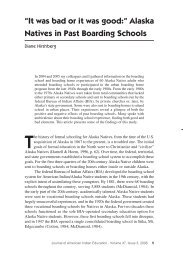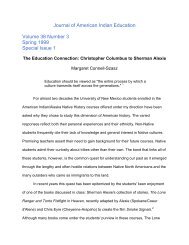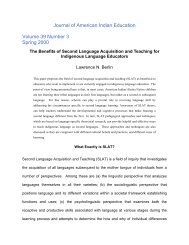Examples from Math in a Cultural Context - Journal of American ...
Examples from Math in a Cultural Context - Journal of American ...
Examples from Math in a Cultural Context - Journal of American ...
Create successful ePaper yourself
Turn your PDF publications into a flip-book with our unique Google optimized e-Paper software.
Curriculum Development: Based on Putt<strong>in</strong>g Pieces Together [Tumaqcat]We have worked with elders <strong>in</strong> a variety <strong>of</strong> situations and contexts and haveexplored a range <strong>of</strong> subsistence-related activities <strong>from</strong> star navigat<strong>in</strong>g to mak<strong>in</strong>gwomen’s cloth<strong>in</strong>g (see Lipka & Yanez, 1998 for a fuller description; Lipka,Wildfeuer, Wahlberg, George, Ezran, 2001; and Lipka, Parker Webster, & Yanez,2005). Many <strong>of</strong> the everyday Yupiaq activities relate well to Bishop’s (1994)conception <strong>of</strong> math across cultures. They <strong>in</strong>clude measur<strong>in</strong>g, design<strong>in</strong>g, count<strong>in</strong>g,and navigat<strong>in</strong>g/locat<strong>in</strong>g, play<strong>in</strong>g, and expla<strong>in</strong><strong>in</strong>g (Bishop, 1994). Based on thesemath topics and Yupiaq cultural activities, we developed a series <strong>of</strong> supplementalmath curriculum for elementary school students <strong>in</strong> Alaska. These supplementalmath curricula modules take approximately six weeks to teach. The curriculabased on the elders’ knowledge <strong>of</strong>ten <strong>in</strong>cludes accompany<strong>in</strong>g stories that connectthe cultural context and the specific cultural activity, the theme <strong>of</strong> each modulesuch as berry pick<strong>in</strong>g, pattern mak<strong>in</strong>g, and others, to specific mathematical topicssuch as data collection and analysis, geometric patterns, and numeration (SeeParker Webster & Yanez, 2007, pp. 120-135).Charles, a pr<strong>of</strong>essor at the University <strong>of</strong> Alaska Fairbanks <strong>in</strong> the AlaskaNative Language Center, spoke poetically about Yup’ik patterns:Tumartat is the gather<strong>in</strong>g <strong>of</strong> pieces <strong>of</strong> anyth<strong>in</strong>g and putt<strong>in</strong>g them togetherto make a whole. We look at what we sew—pieces <strong>of</strong> different types <strong>of</strong> furs,for <strong>in</strong>stance—and we put them together to create one whole. We look at ourpatterns; different shapes are made and sewn together to create a whole.Everyth<strong>in</strong>g around us is a pattern that creates our whole be<strong>in</strong>g (Pendergrast,Lipka, Watt, Gilliland, & Sharp, 2007).Accord<strong>in</strong>gly, this case highlights the authentic putt<strong>in</strong>g together <strong>of</strong> Yupiaqcultural and l<strong>in</strong>guistic knowledge, seamlessly sewn to achieve <strong>in</strong>creased academicperformance <strong>in</strong> mathematics.Patterns and Parkas Module: A specific example <strong>of</strong> everyday geometry andits potential connections to school mathematics. Dur<strong>in</strong>g the course <strong>of</strong> the past fewyears, we met with a small group <strong>of</strong> female Yupiaq elders. They were teach<strong>in</strong>gus how they each make their border patterns (typically applied to a women’s dress).In particular, we were <strong>in</strong>terested <strong>in</strong> how they created their start<strong>in</strong>g piece <strong>from</strong> nonuniformmaterial. On these occasions, we observed the elder while she completedthe process. The elders did not discuss each step as they worked. However whenthe elders completed their work we <strong>in</strong>terviewed them and <strong>of</strong>ten had them repeatthe process until we were able to make the same pattern. At these times, we alsovideotaped the process to ensure that it was carefully recorded and available forfurther reference. It is important to note that different elders choose differentstart<strong>in</strong>g pieces and they have different ways <strong>of</strong> mak<strong>in</strong>g their pieces. Below is anexample <strong>from</strong> W<strong>in</strong>ifred Beans, an elder <strong>from</strong> the village <strong>of</strong> St. Mary’s, Alaska.As we observed Ms. Beans, she took a rectangular-shaped piece <strong>of</strong>cardboard and folded the cardboard lengthwise and then she folded the cardboard<strong>in</strong> half aga<strong>in</strong> width-wise (see Figure 1). She held the folded rectangle, now a<strong>Journal</strong> <strong>of</strong> <strong>American</strong> Indian Education - Volume 46, Issue 3, 2007 101





